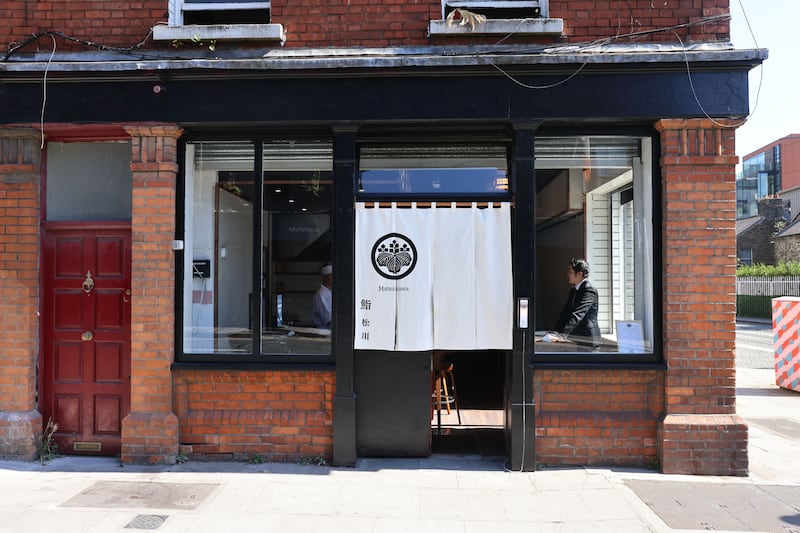It is not often that you visit a restaurant and rather than a “still or sparkling?” inquiry, you are informed that mineral water is included and so too is tea. Not your Barry’s variety, but green tea that has been imported directly from Japan; aracha from Kyoto and hojicha from Nara.
This is an important detail because tea is a good match with sushi and you could happily sip it right through the omakase menu at Matsukawa, Dublin’s newly opened Japanese restaurant in Smithfield, bringing your total bill to €90 for the 18-course menu, plus your tip.
Japanese food is big news at the moment, particularly in London. Sushi master Shinji Kanesaka opened Sushi Kanesaka at the Dorchester hotel in July, making his £420 (€491), 18-course menu the most expensive in the city. Endo at the Rotunda, one of London’s toughest reservations to secure, requires advance payment of £225, and the Kyoto kaiseki menu at Umu clocks in at £250, an experience I enjoyed a few years back. At that level, it never comes cheap.
I adore Japanese food, but here in Ireland we mainly get the mid-level quality tier, unlike London or New York, where there’s a sizeable Japanese community, and indeed, sizeable expense accounts. In Ireland, we have Takashi Miyazaki’s Ichigo Ichie in Cork and Yoshimi Hayakawa’s Wa Sushi in Galway, but it’s debatable whether there is anything of an international standard in Dublin.
Seafood Café restaurant review: A Sunday lunch seafood feast is a wonderful thing, especially at this price
Indo-Chine restaurant review: There’s a buzz about this vibrant Dublin 4 neighbourhood place
The Unicorn restaurant review: Legendary Dublin hotspot returns, but does the magic?
Poulet Bonne Femme takeaway review: Delicious and succulent roast chicken with all the trimmings

Matsukawa feels delightfully Japanese. It is named after the owner Yu Uchida’s grandmother’s restaurant, and printed on the white curtain that hangs outside the door, leading to a compact, simple room. There are eight stools at the sushi counter and a couple of two-seater tables. The team is Japanese. Takuma Tamaoki, the chef, (described as a “sushi artist”), previously worked in Tokyo and in Wa Sushi, and Uchida, who is also a chef, comes from a family of restaurant owners.
All of the eight high stools have a good view of the sushi action, but avoid the two less comfortable grey ones by the window (there was an issue with delivery). The prospect of chilled sake (€12) and a glass of Ochota Barrels Texture Like Sun field blend (€9.50) quickly distracts us. We get to choose which glass we would like, and as the counter fills up, the service starts. A pot on the small stainless steel hob exhales gentle puffs of steam, Tamaoki grates the fresh wasabi imported from Shizuoka in Japan, and sharp knives are on hand for the precise slicing of raw fish.
A small dish of masago salad, two slivers of fish with seaweed, and another of marinated ginger with seaweed, cucumber and capelin roe, are followed by hamachi and salmon sashimi, served on a shiso leaf with a dab of wasabi, which is creamy with a persistent, gentle heat. It is quite different from the bright green horseradish imitation you find in more mainstream sushi joints.

The hot course is chawanmushi, the steamed, savoury custard that has found its way on to Michelin-starred menus such as Frantzen in Stockholm and Terre in Castlemartyr. It’s a delicate custard, revealing little surprises as you dig in with the wooden spoon, shiitake mushroom, a piece of mackerel and an edamame bean.
And then it’s the sushi course, 10 different types of nigiri and one maki. While many assume that sushi is all about how the fish is cut, it in fact refers to the seasoned rice. At Matsukawa, the rice is as it should be, body temperature, slightly sweet and tart from vinegar, with distinct grains of rice that are not too sticky.
Highlights are the pickled mackerel, which is meaty with a gentle acidity; turbot which is dotted with torched sweet miso, eliciting a scorched caramel flavour, blue fin tuna which has been marinated in shoyu and aged for five days, and blue fin otoro which is soft and silky.
Cold towels have been replaced halfway through our meal and, as is tradition, the sushi course ends with tamagoyaki, a slightly sweet egg omelette. A bowl of white miso soup is followed by a simple dessert of gold kiwi with red beans in a red bean jelly.
Is everything perfect? Not quite. Some of the sushi is of notably better quality than others, and there is a certain sameness about 10 pieces of nigiri. The omelette, a challenging dish to make, lacks the rolling technique required to pass the Jiro Ono test. But Matsukawa is charming, with delightful service and is certainly something new for Dublin.
Dinner for two with four drinks was €215.50.
The verdict: Freshly made sushi in a thoroughly Japanese room.
Music: Background jazz.
Food provenance: Glenmar Seafood, Tazaki Food.
Vegetarian options: No vegetarian options yet; a vegan menu is planned.
Wheelchair access: Accessible with accessible toilet.




